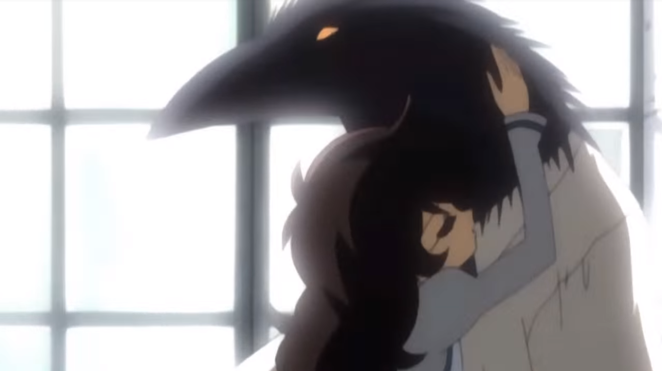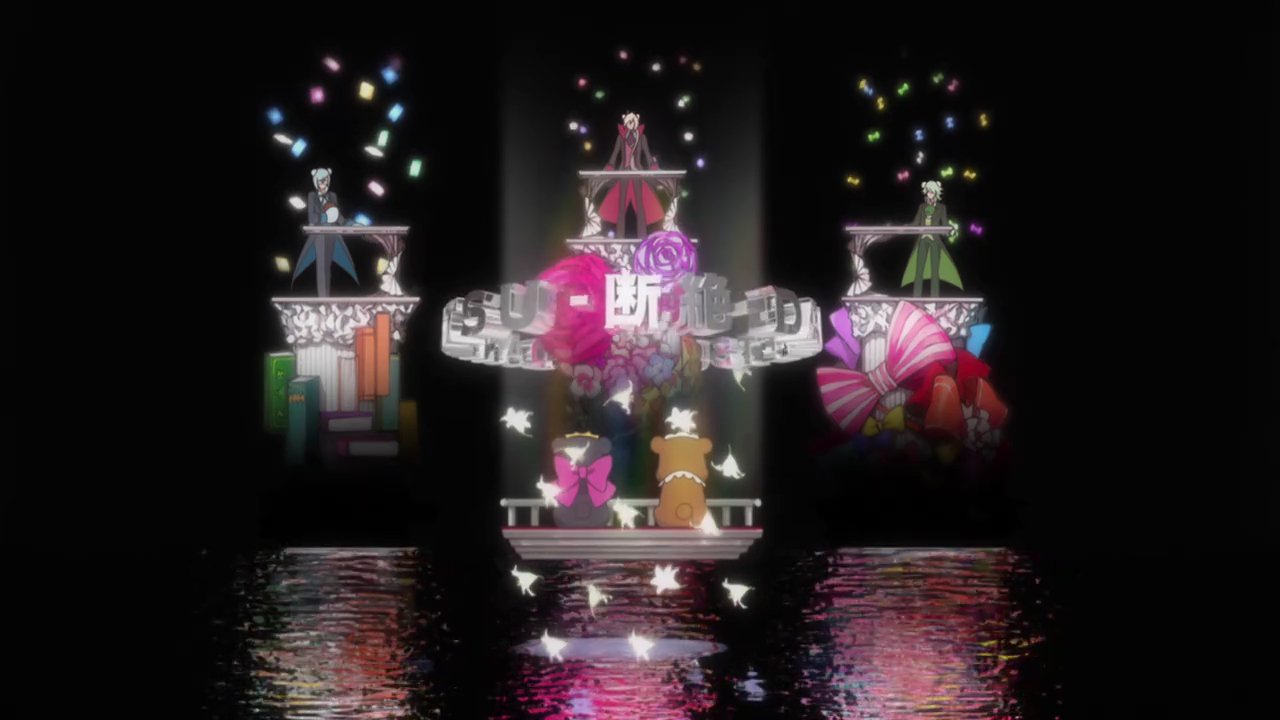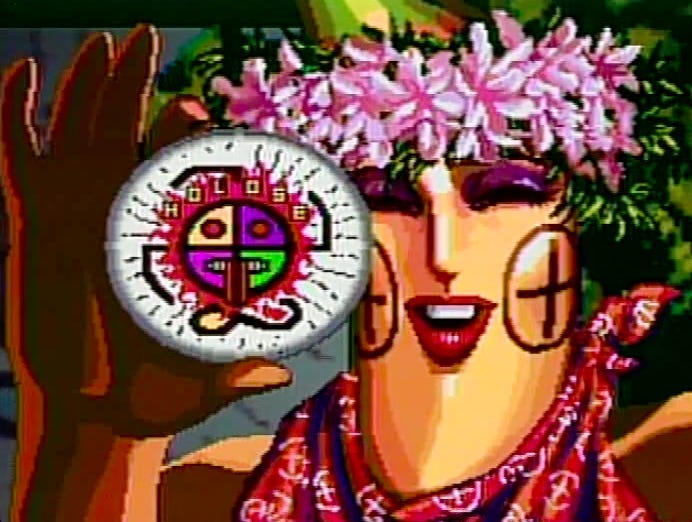For the other Retrospective posts for the first 100 anime covered on the blog, follow the links here for Worst Anime Covered, the Strangest Anime and Best Bonus Review, and Best Song and Best Opening and Ending Credits.
Best Score
10. Avalon (2001) (Composer Kenji Kawai)
This is one (live action) film that should be included as, considering Kawai is a veteran who has worked with director Mamoru Oshii a lot, his bombastic operatic score is just as emotionally stirring as his iconic work on Ghost in the Shell (1995) was.
9. Yurikama Arashi (2015) (Composer Yukari Hashimoto)
Befitting Kunihiko Ikuhara, his 2015 consists of a surprising amount of electro-pop which, rather than putting me off, felt absolutely appropriate for the pop-surrealism onscreen. Composer Yukari Hashimoto, having worked with him on Mawaru Penguindrum (2011), really did her best here.
8. Lupin III: The Mystery of Mamo (1978) (Composer Yuji Ohno)
Already a composer on the 1977 Lupin III series, and soon after working on the iconic The Castle of Cagliostro (1979), Ohno (also a jazz musician) was naturally going to know how to score this character's world with ease. Even if you discount just how awesome the version of the iconic Lupin III theme is here, hearing jazz combined with electronic noise and at times about to turn into disco, knee deep into the seventies lounge music, is pretty good stuff.
7. Royal Space Force – The Wings Of Honneamise (1987) (Composers: Ryuichi Sakamoto, Yuji Nomi, Koji Ueno, Haruo Kubota)
Exceedingly low for Ryuichi Sakamoto on this list admittedly, a man who also in 1987 composed the score to Bernando Bertolucci's The Last Emperor with Cong Su and Talking Heads' founding member David Byrne, thus winning a Best Score Academy Award between them, but honestly including this at any position is not blasphemous as long as the score for Honneamise is at least recognized. Sakamoto is such an important figure in Japanese music and a legendary composer, one with a peculiar and diverse soundtrack worth exploring, but everyone else involved helped build this incredibly moving score. The entirety of The Wings of Honneamise, studio Gainax's first major production which was a struggle to complete, was an ambitious and still awe-inspiring attempt at serious and intelligent science fiction, so the score as well should naturally fit the existential and spiritual layers the film itself gets to.
6. Samurai Flamenco (Composers: Agehasprings and Kenji Tamai)
The light jazz motif, that plays in the light hearted moments, was what I immediately pricked my ears up upon hearing and started my love for this show score. It was a great series which, even in the quiet scenes, had non-digetic music that added to the mood perfectly, all before you get to the more bombastic moments.
5. Vampire Hunter D: Bloodlust (2000) (Composer: Marco D'Ambrosio)
Bloodlust is a fascinating time capsule - not just for tragically the last gasp of painstaking and incredible hand drawn animation, but that in the midst of a greater Western interest in anime this was effectively a US-Japanese co-production to the point the English dub came first, the Japanese one only appearing time later and (sadly) not allowed to be released outside of Japanese physical media even a decade later. It also meant that a Western composer Marco D'Ambrosio helmed the music, tragically never working on any prominent film or work to this day. That's particularly the case as, befitting a franchise which is a hybrid of genres, he knocks this score out of the park in operatic bombastic, electronic noises and a grandiosity befitting this incredible production.
4. Robot Carnival 1987 (Composers: Joe Hisaishi, Isaku Fujita and Masahisa Takeichi)
Joe Hisaishi is a legend just for his work with Hayao Miyazaki and "Beat" Takashi Kitano, but his career occasionally strayed out of these two figures' filmographies too. In the eighties, here with Isaku Fujita and Masahisa Takeichi, he had a considerable challenge to come up with eight completely different types of score for eight different type of anthology animated segments merely tied together by their theme of robots. Even the cheese fest of eighties guitar in Deprive, or the eighties synthesizer cheese of Star Light Angel, is exceptional especially when contrasted by the ambient (for the experimental Cloud) to the appropriately absurd for period farce Strange Tales of Meiji Machine Culture: Westerner's Invasion.
3. Boogiepop Phantom (Atsushi Yabe and Hideki Amano)
In lieu to the idea that a soundtrack can amplify the images, Boogiepop Phantom cements the incredible weight a great one can have, especially as part of it's genius is that it absorbed pure noise and sound as tools to use to induce eeriness on the viewer. Particularly for the horror genre, where music is such a vital tool that has to be good or at least memorable, or everything is marred, everyone who worked on the series should've been proud.
2. Belladonna of Sadness (1973) (Composer: Masahiko Sato(h)*
It's not period accurate to medieval France, but Belladonna of Sadness' incredible limited animation aesthetic animation is appropriately melded with psychedelic rock which at times even turns into acid rock, guitar riffs enough by themselves to induce psychotropic images if the film itself wasn't already producing ones onscreen.
1. Paprika (2006) (Composer: Susumu Hirasawa)
When I covered this film, what else but this soundtrack gets the Number 1 spot? In comparison to Paranoia Agent (2004), which was gorgeous but did have to repeat a limited series of motifs, for the theatrical feature by the late Satoshi Kon the soundtrack itself became as iconic as the film itself, arguably having an incredibly positive effect on widening Susumu Hirasawa's potential audience because it had an actual physical release (and iTunes release) in the West. Not surprising, in-between jaunts into even circus music, his trademark world music influenced synth pop is absolutely unique and awe-inspiring.
Most Unique Aesthetic
10. Princess Tutu (2002-3)
Even on a TV production from the early 2000s, when the introduction of digitally painted animation did frankly cause a lot of productions to stumble aesthetically for a few years, Princess Tutu's fantasy world which drew on European fairy tales and ballet was its own beautiful little globe. Literally, as part of the series' lore, which made the aesthetic even more vital, was that it was all contained in the one town the show is set in. Any further than this is a spoiler, suffice to say its a children's show which yet has the kind of deliberate artiness to match other contenders on the list, with motifs and symbolism rife to pick apart and gain greater depth from.
9. gdgd Fairies (2011/2013)
Usually when something's done terribly on purpose, its for irony and just tedious. gdgd Fairies is a strange and wonderful case as, yes, it was probably animated to look this cheap both for cost and because it made the creators laugh, but oh my did they run the gauche digital models and backgrounds into the ground to the point it became sincerely awesome. From using them for jokes about word punning to the elaborate games being played, from a perversion of a karting video game to the biggest Rube Goldberg machine machine possible, gdgd Fairies found gleefully weird ways to make itself funnier as it went along.
8. Yurikama Arashi (2015)
Creating an entirely (well mostly) female world separate between women and bears is a jumping off point for a work where distinct design and colour schemes rule. This is Kunihiko Ikuhara after all too, so the symbolism is insane in its depth and even the things which were probably just for aesthetic pleasure for him are gorgeous to look at.
7. Night is Short, Walk on Girl (2017)
Likewise, Masaaki Yuasa's work is entirely unique, though I'm not going to stumble into talking about the "Superflat" art movement, which has been brought up with Yuasa, as a) that's a complex subject I barely know a lot about and b) it feels alien, considering the Superflat movement is about the flatness of pop culture, when Yuasa's work has always been emotionally deep even when incredibly weird. It's more a case that, in his hyper stylished aesthetic that is drawn from influenced even as far as Yellow Submarine (1968), he exaggerates and distorts to perfectly depict these emotions and action.
6. Boogiepop Phantom (2000)
From its incredibly washed out look, to the potentially problematic issue that individuals can becoming confusing to differentiate, Boogiepop Phantom's aesthetic choices are both alienating but also absolutely perfect for this dread inducing, weird horror/sci-fi premise which involves memory returning phantom butterflies to balloons which steal your inner child from you. Hopefully, pray, the new 2019 adaptation doesn't delete this version from existence as its art style is more than worthy of remembrance. Fingers are crossed, as well, the other way around that the 2019 version did its own ambitious aesthetic tricks with the material too.
5. Requiem From The Darkness (2003)/Mononoke (2007)
Turning the final years of the Edo period into a nightmarish world full of strange touches, like all the equivalent of the police having wooden block heads like training dummies or the protagonist's publisher being a tiny little imp, Requiem From The Darkness even before you get to its dark fantasy horror sets the tone perfectly.
In a controversial move, I'll include Mononoke as a joint entry as, both as much more mature period horror series, with individual stories but witnessed by the same protagonists, the pair make a great duo in their aesthetics. Particularly if you cannot get away with overt violence or very disturbing content on television, what the duo do in their own ways really help a lot in having an impact. Both feel like taking acid too, Mononoke's bright and truly unique aesthetic matched by the fact that, yes, it manages to tackle very dark and unconventional subject matter, whilst still being a good horror series, through symbology and great production style too.
4. The Flying Luna Clipper (1987)
Completely animating a film from the graphics of a video game console, the MSX here, is a test for any animator to try, more so as long before we became obsessed with "pixel art" this film does its best to promote said console as the best looking possible, its lush Hawaiian surreal aesthetic matched with moments of live action. The eeriness of its "stilted" animation, alongside how weird the film is, creates something incredibly unique as a result.
3. Midori (1992)
Just for the fact director Hiroshi Harada worked on this project for years by himself, and how good it looks, you have to admire Midori, but this grotesque film also has an incredibly unique style, aptly taking its influence both from the original manga author Suehiro Maruo's source material (and style), but also the fact this is a period film set within the early Shōwa period when ero-guro grew into existence as an art movement. There are moments in Midori which are gross and horrifying, but the limited animation and style of the production is undeniably gorgeous.
2. Belladonna of Sadness (1973)
Taking unconventional and limited animation to its extreme, the last hurrah before Mushi Productions, Osamu Tezuka's anime studio, went out of business did so drawing on Art Nouveau influences to create a film that looks like no other Japanese animation in existence, again gorgeous even when dealing with incredibly dark subject matter including rape, a style which doesn't undercut this darkness, never feels into feeling like pure softcore when it comes to the sex and nudity, and is absolutely captivating to the point any screenshot could be hung off a wall of an art gallery.
1. Royal Space Force – The Wings Of Honneamise (1987)
In terms of aesthetic, whilst its not the most unique, Honneamise takes anime production to an extreme in how, working with its lore and story, it had to create a world like ours but was entirely unique to itself. From the iconography to how the aesthetic of their religious institutions looks, even how eating utensils are entirely different from ours, Honneasmise is awe-inspiring in how precise and elaborate it had to be in creating a new planet and world with unlimited possibilities left untouched outside the main plot point. You could comb this film over multiple viewings and probably find background or little details which would add a new sliver to their world. The result, likely arduous, is captivating as a result and is still seen as a badge of pride for Studio Gainax for good rerason. What happens if the sequel, Uru in Blue, ever comes about and how it could follow up on this craft in the modern day is one to be intrigued but also scared about.
======
* On iTunes/Spotify they have the purchasable version of the Belladonna of Sadness soundtrack by Masahiko Sato without the "h" at the end, which leads to some annoying confusion.

:format(jpeg):mode_rgb():quality(90)/discogs-images/R-2742604-1299006356.jpeg.jpg)
:format(jpeg):mode_rgb():quality(90)/discogs-images/R-317285-1514591137-6557.jpeg.jpg)











No comments:
Post a Comment